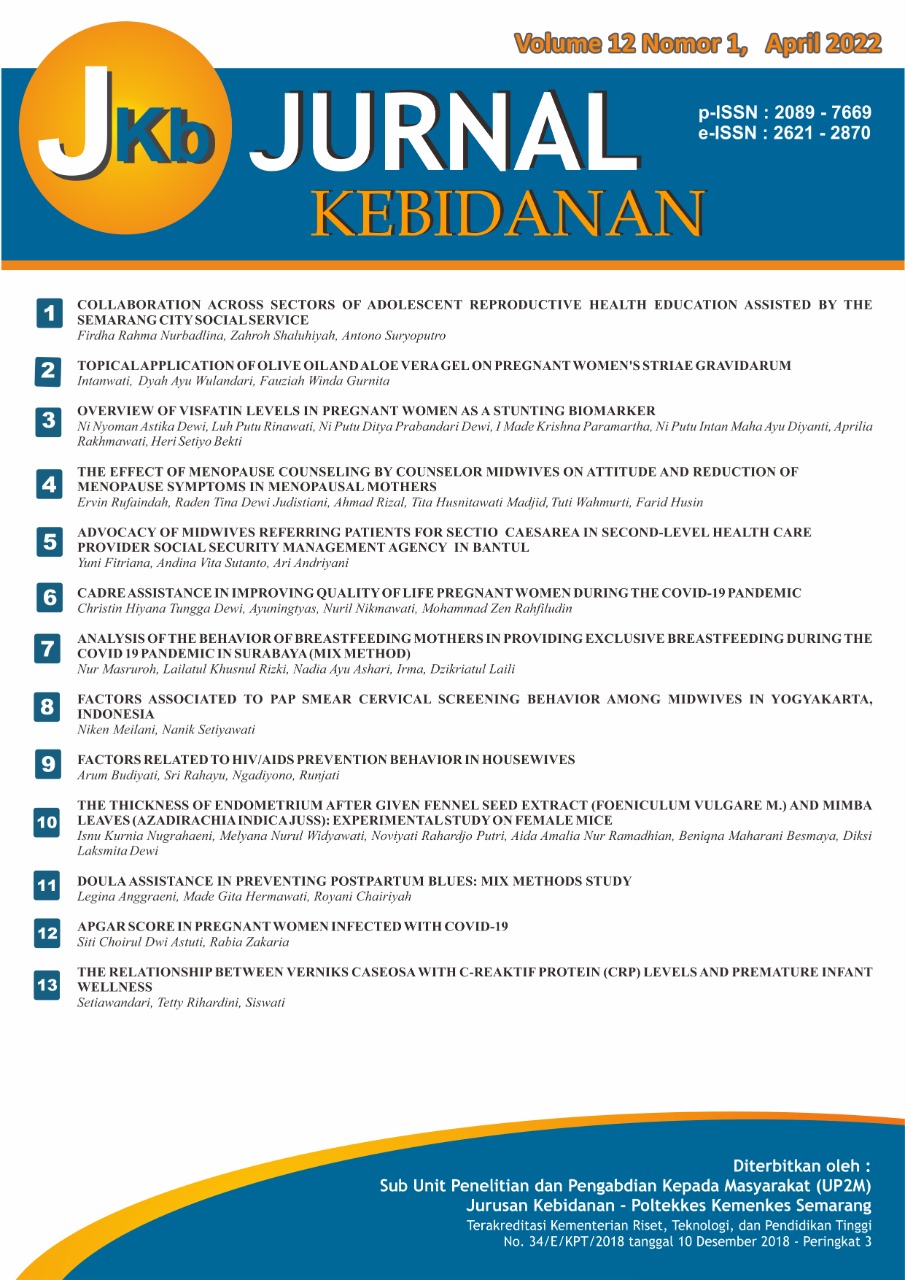Advocacy of Midwives Referring Patients for Sectio Caesarea in Second-Level Health Care Provider Social Security Management Agency in Bantul
DOI:
https://doi.org/10.31983/jkb.v12i1.7726Keywords:
midwives, sectio cesarea, social security management agencyAbstract
Some women consider vaginal delivery to be a difficult and dangerous delivery process so that Sectio Cesarea (SC) tends to be chosen even though the SC method has a risk of infection. In the past, SC was still a scary thing, but with midwifery technology the paradigm is starting to shift. Now SC delivery is often an alternative choice of delivery even without medical indication. Midwives cannot refer without medical indication if using BPJS Kesehatan. This qualitative descriptive study with an empirical judicial approach, namely analyzing the trend of increasing SC action in private hospitals, types of medical indications and non-medical indications for SC action, advocacy of midwives in referral of SC patients, and collaboration between midwives and Second-Level Health Care Provider Social Security Management Agency. The results of the SC action study were based on medical indications according to 19 screening for mothers who gave birth to be referred. Children are expensive, cannot stand the pain and can't wait to go through the labor process as a reason for non-medical indications for SC action, Midwives advocate for normal delivery if there is a medical indication that a referral will be made, Midwifery collaboration is carried out according to Social Security Management Agency provisions and there is no fee, except for general patients but it was the doctor who provided not the referral hospital. Midwife advocacy is needed to be able to suppress SC action without medical indication and the Government can improve Social Security Management Agency services to be more integrated.
References
N. Sihombing, I. Saptarini, and D. S. K. Putri, “The Determinants of Sectio Caesarea Labor in Indonesia ( Further Analysis of Riskesdas 2013),†J. Kesehat. Reproduksi, vol. 8, no. 1, pp. 63–75, 2017,
I. Salfariani M and S. S. Nasution, “Faktor Pemilihan Persalinan Sectio Caesarea Tanpa Indikasi Medis Di Rsu Bunda Thamrin Medan,†J. Keperawatan Klin., vol. 1, no. 1, pp. 7–12, 2012.
Nurhaidah, “Aspek Hukum Paket Hemat sectio Caesaria dari Rujukan Bidan di Rumah Sakit X,†Universitas katolik Soegijapranata Semarang, 2011.
Kemenkes RI, “Hasil Riset Kesehatan Dasar Tahun 2018,†Kementrian Kesehat. RI, vol. 53, no. 9, pp. 1689–1699, 2018.
Y. Dinkes, “PROFIL KESEHATAN 2019 KOTA YOGYAKARTA (Data Tahun 2018),†J. Kaji. Ilmu Adm. Negara, vol. 107, pp. 107–126, 2019,.
Dinas Kesehatan Bantul, “Profil Kesehatan Kabapaten Bantul 2020,†Profil Kesehat. Kabapaten Bantul 2020, vol. 3, no. 4, pp. 1–47, 2020.
D. Ayuningtyas, R. Oktarina, M. Misnaniarti, and N. N. Dwi Sutrisnawati, “Etika Kesehatan pada Persalinan Melalui Sectio Caesarea Tanpa Indikasi Medis,†Media Kesehat. Masy. Indones., vol. 14, no. 1, p. 9, 2018,.
Sofyan Mustika, Bidan Menyongsong Masa Depan, 1st ed. Jakarta: Pengurus Pusat Ikatan Bidan Indonesia, 2004.
Kemenkes RI, “Permenkes no 71 tahun 2013 tentang pelayanan kesehatan pada JKN,†2013.
Lexy J Moleong, Metodologi Penelitian Kualitatif Edisi revisi. Bandung: PT. Remaja Rosdakarya, 2018.
MPR, “Negara Republik Indonesia Tahun 1945,†pp. 1–166, 2011.
P. Indonesia, “Undang-undang no 40 tahun 2004 jaminan Sosial nasional,†CWL Publ. Enterp. Inc., Madison, vol. 2004, p. 352, 2004,
P. Indonesia, “Undang-undang no 24 tahun 2011 tentang BPJS,†Peratur. perundang-undangan, pp. 138–155, 2011.
P. Indonesia, “Undang-undang no 36 tahun 2014 tentang Tenaga Kesehatan,†no. 1, 2014.
P. Indonesia, “Undang-undang no 44 tahun 2009 tentang Rumah sakit,†Peratur. perundangan, no. 57, p. 3, 2009.
P. Indonesia, “Undang - Undang RI No 4 tahun 2019 tentang kebidanan,†Undang. Republik Indones. Nomor 4 Tahun 2019, vol. KEBIDANAN, no. 004078, 2019,.
Kepmenkes, “Keputusan Menteri Kesehatan Republik Indonesia Nomor 369/Menkes/Sk/Iii/2007 Tentang Standar Profesi Bidan Menteri Kesehatan Republik Indonesia,†Kemenkes RI. p. 3, 2007.
kemenkes RI, “Permenkes no 28 tahun 2017 tentang izin dan penyelenggaraan praktik bidan,†Peratur. perundangan, no. 8.5.2017, 2017.
Marmi, Intranatal Care Asuhan Kebidanan Pada Persalinan. Yogyakarta: Pustaka Belajar, 2016.
Kurniarum Ari, “Asuhan Kebidanan Persalinan dan bayi baru Lahir,†Modul bahan Ajar cetak Kebidanan, vol. 1, p. 162, 2016.
O. I. Akinola, A. O. Fabamwo, A. O. Tayo, K. A. Rabiu, Y. A. Oshodi, and M. E. Alokha, “Caesarean section - an appraisal of some predictive factors in Lagos Nigeria,†BMC Pregnancy Childbirth, vol. 14, no. 1, pp. 1–6, 2014,.
D. Kasdu, Operasi caesar: masalah dan solusinya, Cetakan ke. Depok: Puspa swara, 2005.
T. Solehati and C. E. Kosasih, Konsep dan Aplikasi Relaksasi: dalam perawatan maternitas. Bandung: Refika Aditama, 2015.
U. rahman Tanjung, “Analisis faktor keputusan persalinan dengan sectio caesaria di Rumah Sakit Umum Daerah Gunungsitoli Kab. Nias Tahun 2018,†Adv. Opt. Mater., vol. 10, no. 1, pp. 1–9, 2018,.
S. C. . Cunningham F.G., Leveno K.J., Bloom S.L., Hauth J.C., Rouse D.J., Obstetri Williams, Edisi 12. Jakarta: EGC, 2006.
L. Lisnawati, Asuhan Kegawatdaruratan Maternal dan Neonatal. Bogor: Trans In Media, 2013.
M. M. B. Sembiring, “gambaran determinan Permintaan Persalinan Sectio caesarea tanpa Indikasi Medis di RSU X tahun 2014,†Karya Tulis Ilm. Progr. DIV Bidan Pendidik Fak. Keperawatan Univ. Sumatera Utara, vol. 1, no. 3, pp. 82–91, 2014.
N. Ketut Sukasih, I. Maliga, and E. Gustia Kesuma, “Analisis Faktor Non Medis Yang Mempengaruhi Persalinan Sectio Caesaria Di Rumah Sakit Umum Daerah Sumbawa,†J. Kesehat. dan sains, vol. 4, no. 1, pp. 93–105, 2020.
R. Choirunissa, “Analisis Motivasi Bidan Dalam Merujuk Pasien Untuk Dilakukan Tindakan Sectio Caesarea di PPK II BPJS di Wilayah Kecamatan Makasar Jakarata Timur Tahun 2014,†J. Ilmu dan Budaya, vol. 40, no. 54, pp. 6123–6138, 2014.
D. . Bobak, I.M., & Lowdermilk, Buku Ajar Keperawatan Maternitas, Edisi 4. Jakarta: EGC, 2005.
et al. Lumbiganon P, Laopaiboon M, Gülmezoglu AM, Souza JP, Taneepanichskul S, Ruyan P, “Method of Delivery and Pregnancy Outcomes in Asia: the WHO Global Survey on Maternal and Perinatal Health 2007-2008,†Lancet, vol. 2010 Feb 6, 2010.

